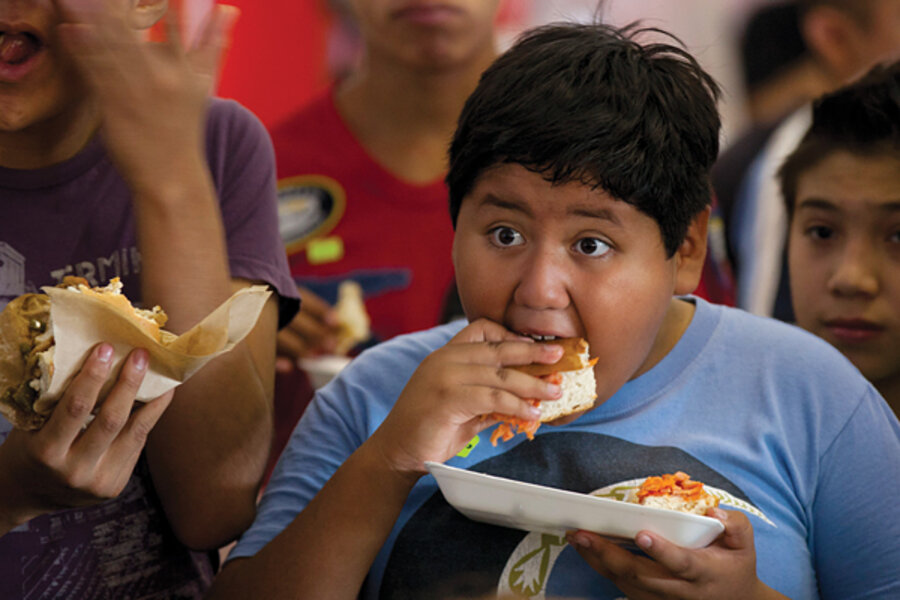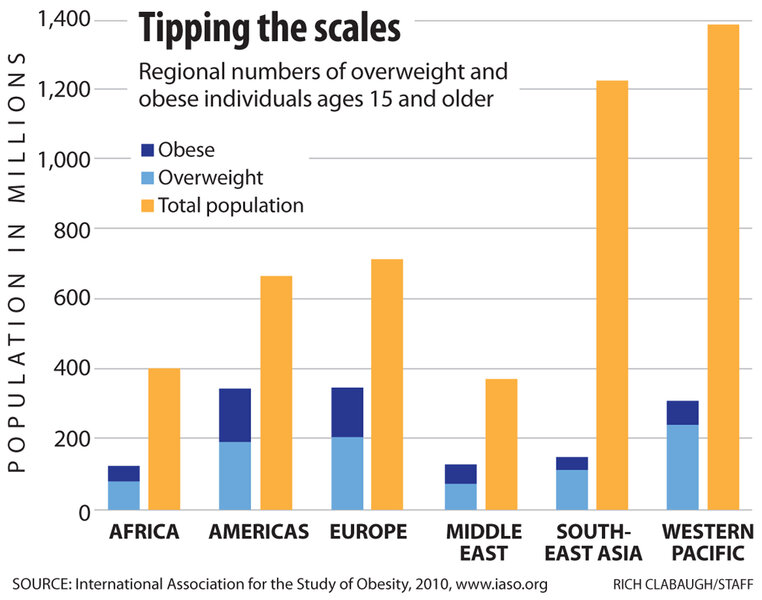Obesity weighing on America – Latin America, that is
Loading...
| Santiago, Chile; and Mexico City
It's a gloomy day in downtown Santiago, Chile. Men and women in dark clothes hustle down a pedestrian mall, rushing back to work as their lunch break ends. But for many children, the gray scene is pierced by a beacon: a local McDonald's restaurant with bright, wall-sized posters of ice-cream cones and hamburgers, a warm entryway, and especially the promise of children's meals with toys tucked inside.
If Chilean Sen. Guido Girardi has his way, however, there will be no more "Ice Age" figurines or other cartoon-movie icons to tantalize tots. Senator Girardi filed a complaint Aug. 1 against McDonald's, Burger King, and Kentucky Fried Chicken for allegedly marketing to children using toys, and demanded that the nation's health ministry crack down on food manufacturers that use stickers, games, or other child-friendly paraphernalia to draw in the youngest consumers.
The move comes as Chile's waistline continues to expand. With a quarter of Chileans registering as obese, the Andean country's residents are now almost as overweight as the British, and quickly catching up to North Americans.
Recent studies show almost a quarter of first-graders in Chile are clinically obese, which means they have a body mass index (BMI) – their weight in kilograms divided by the square of their height in meters – of 30 or more.
Chile is not alone in Latin America. Mexico is vying with the United States for the distinction of being the world's heaviest nation, depending on which demographic is being studied. Only North America exceeds South America in terms of how heavy the population is. Even in Central America, where some countries are more associated with malnutrition, obesity rates are increasing.
The fattening of Latin America follows global patterns that have rendered 1.5 billion adults worldwide overweight or obese: Women are working outside the home, free trade has meant easy access to processed foods and sweetened beverages, jobs are more sedentary, and kids have moved from the soccer field to the television set. And with incomes rising in low- and middle-income countries, obesity is something that developing-world politicians will increasingly have to battle as food and beverage manufacturers eye new markets.
"There is an increased push by global food companies," says Barry Popkin, a global nutrition expert at the University of North Carolina at Chapel Hill. "Because of growing incomes in Brazil and all the growth in China," he cites as two examples, "they are putting their efforts there now."
Mexico saw one of the quickest increases in obesity rates in the world between 1990 and 2010.
A diet that used to be based on corn and beans, flavored with tomatoes and peppers from the fields, is now increasingly industrially packaged. Fried food is everywhere, with the prices of cooking oils way down. At almost any time of the day, children and adults alike snack on everything from supersize juices to cobs of corn smothered in mayonnaise. Coca-Cola is gulped in vast quantities: Mexico is the biggest consumer of the soda on the planet.
According to Mexican government statistics, 70 percent of Mexican adults are overweight or obese (29 percent of that tally are obese). More than one-quarter of children ages 5 to 11 are overweight. Forty percent of children and adolescents do not exercise. The difference between an overweight and obese BMI is a jump from 25 to 30 on the index.
Though obesity has historically been higher in the developed world, studies have shown that obesity rates in Latin America have exceeded those in many developed countries, says Jason Nagata, a medical student at the University of California, San Francisco who has conducted obesity research in Guatemala.
In this Central American country, which has had one of the highest rates of malnutrition for children in the world, the prevalence of residents who are overweight or obese increased from 34 percent in 1995 to 45 percent in 2002.
In Mexico, the government is taking action. Under the administration of President Felipe Calderón, it signed the Obesity Prevention Strategy, which, among other things, banned sodas from schools and removed most high-sugar and fatty foods. The government also shifted from whole to 1.5 percent milk for government programs.
But Juan Rivera, director of the Center for Research in Nutrition and Health at Mexico's National Institute for Public Health, says that public awareness with the help of the media has probably had the biggest impact.
Recently, the secretary of health turned to the well-loved figures of Mexican wrestling, called lucha libre , who are leading a program called "Wrestling Against Obesity." (See story here.)
At the popular matches, information booths about good eating habits and disease prevention will be set up through November to help orient Mexicans toward a healthier lifestyle.
"The level of awareness of people about obesity and problems associated with it is higher," says Dr. Rivera. "There was not a single day in the last six years when you did not see news in Mexico about obesity." He says that preliminary results from the 2012 national nutrition survey, not yet published, show a halting in the accelerated rates of obesity logged over the past 20 years.
Chile has also tried to aggressively address its obesity epidemic, passing a law July 6 requiring that high-salt and high-calorie foods be labeled as such, for example. The law also makes it illegal to give out samples of such food to children, sell them at schools, or advertise them to kids. Schools, which sometimes keep students at the same desk all day, will have to provide physical activity and sports.
Francisco Mardones, a professor of public health at the Pontifical Catholic University in Santiago, says the government is also paying attention to prevention. For example, studies show that obesity is a bigger problem for children who are breastfed for less than six months. He says Chile's extension of maternal leave to six months, passed this year, is an "important" part of the solution. In addition, the new food law requires infant formula to be labeled with a notice about the superiority of breastfeeding.
But Chile and Mexico, along with some efforts in Brazil, stand alone in aggressively tackling the issue in this region, says Dr. Popkin. "It is starting to get attention," he says, "but generally speaking the food industry is just too big and powerful."
And even where politicians have directly tried to take on industry, they haven't gotten far. In Chile, for example, the new law won't translate immediately into new corporate policies.
"The sale of food specially oriented toward children may not be brought about through commercial hooks unrelated to the promotion of the product itself, such as gifts, contests, games, or other elements that attract children," the law reads.
But "commercial hooks" remains to be defined. The rule that will convert this law into enforceable specifics has yet to be issued, Girardi's lawsuit against fast-food companies notwithstanding. For now, restaurants continue to give out toys.
If the government's goal is to get kids to eat healthier food, they might have an ally among the 3-year-old set. Entering a McDonald's in downtown Santiago, Yesenia Mardones says her son Nicolas wants a Happy Meal for the toy. And the food? "He only eats one or two fries," she says. "And the apple."








